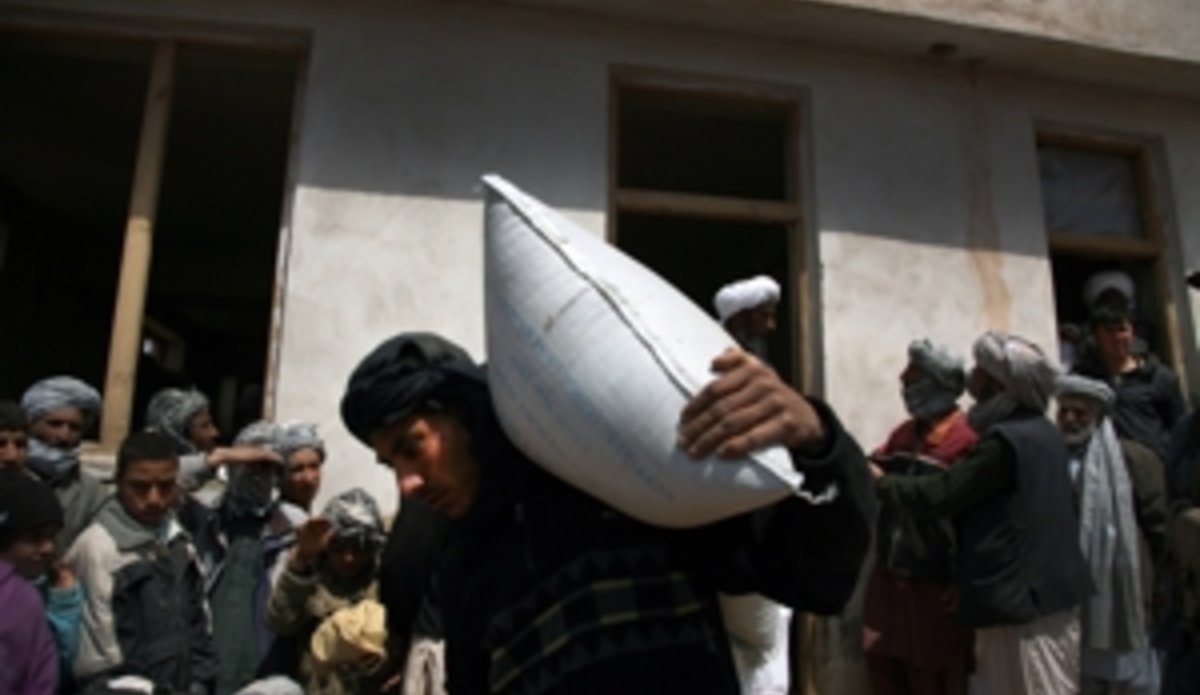WFP distributes 60 metric tons of food to Khosan workers
11 April 2010 - Mohamed Yacoub, 60 years old, collects a bag full of wheat and peas, a can containing cooking oil, a small portion of salt. His hands are thick from working the land; his face burnt spending days under the sun. The wind blows on the outskirts of Khosan district centre, Mohamed Yacoub’s home town, covering him with dust.
“I have worked for 60 days cleaning the canal,” says Mr Yacoub, “and today we have enough water to irrigate our land.” He remembers the past year, when he had to stop working for 10 days in order to clean the Herai Rud canal, damaged by floods. It took a toll on his already-sparse resources.
This year, at the request of the United Nations Office on Drugs and Crime (UNODC), the World Food Programme (WFP) compensated the workers by distributing daily rations to those who rehabilitated the community’s common asset, the lifeline of the district – the water canal.
Around Mohamed Yacoub, people from nearby villages have assembled. In all, 700 workers received close to 60 metric tons of food from the United Nations agency. All have contributed work time to one of two livelihood projects organized in coordination with UNODC.
To ensure that the improvement lasts, the UNODC simultaneously planned an ambitious land-stabilisation program. The agency expects to counter the effect of the past years of drought and the ensuing deforestation as farmers cut the already-meagre vegetation for cooking and for animal fodder, aggravating the precarious condition of their environment. As a result, sand had blown onto the fields and into the canal.
Despite the presence of the main border post with Iran, the population of Khosan district is poor. Most rely on agriculture for their livelihood. Though the district is considered poppy-free, drug trafficking remains a problem. Those who can’t find work travel to Farah or Helmand, where they receive 500 Afghanis a day for harvesting the poppy.
Khosan District Governor Noor Ahmad Haftballah welcomes visitors to his office with courtesy. He has received many, and few have come back to fulfil their promises. Satisfied with the current initiative, he calls for more development in his area. To him, only such programmes may help preserve a fragile stability in his area: “During their stay, 200 to 300 workers will establish contact with anti-governmental elements. They know everything about this district and can create a significant problem.”
Three years will be needed to stabilize the land. Aziz Ahmad, an agronomist for the non-government organization Danish Committee for Aid to Afghan Refugees (DACAAR), was selected to implement the project. He appears oblivious to the immensity of the task ahead of him; and is proud of DACAAR’s recent achievements: “To this day, 40,000 saplings have already been planted. Meanwhile, 70,000 seeds have been sown on one jerrib (2,000 square meters) of land.” Once grown, they will be transported to the desert.
WFP also distributed food to those who planted the bushes and those who will be watering them during the coming year. The sapling bushes, selected for their resistance to drought, will grow and scatter their seeds to generate the new vegetation of this land.
Meanwhile, the population of the district centre collects the assistance provided by the UN agencies. Before sunset, the streets of Khosan are still alive with people carrying home their bags of food – some of them riding on their donkeys, their wheel carts or motorbikes.
By Fraidoon Poya and Henri Burgard, UNAMA
 UN
UN






